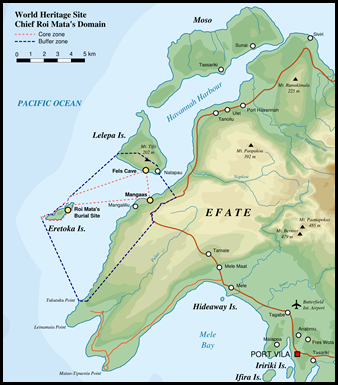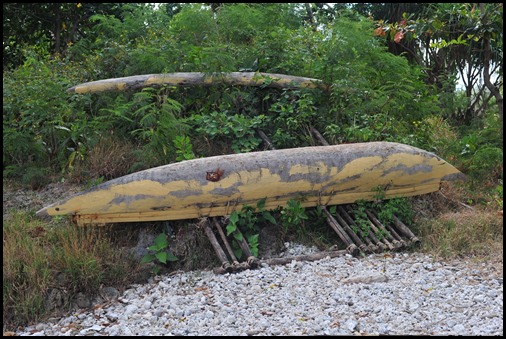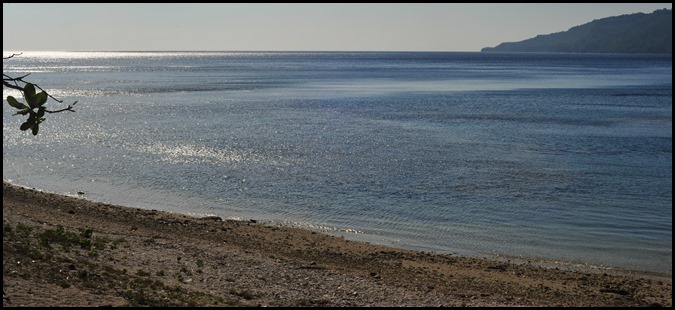Roi Mata Tour

|
Roi Mata Cultural
Tour
  This morning bright and early Topei our guide for the
day and Sael our taxi driver picked us up and took us to the
Cultural Centre to begin our day. We were to learn about Roi Mata a
legendary chief, we had looked him up and Wiki had told us:
Roimata was a powerful 13th
century Melanesian chief from what is now Vanuatu. His elaborate
grave, containing the bodies of over twenty five members of his retinue, was
discovered by French archaeologist Jose Garranger in 1967 and inscribed on
the World Heritage
List in
2008. Garranger was able to locate the grave on Efate, Lelepa and UNESCO World Heritage Sites.
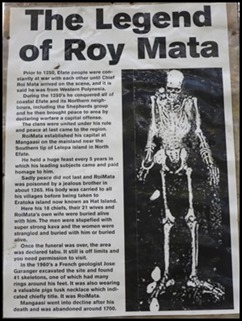
Yesterday at the Secret garden we had read that prior to 1250, Efate people were constantly at war with each other until Chief Roi Mata arrived on the scene, and it is said he was from Western Polynesia. During the 1250’s he conquered all of coastal Efate and its northern neighbours, including the Shepherd’s group and then he brought peace to the area by declaring warfare as a capital offence. The clans were united under his rule and peace at last came to the region. Roi Mata established his capital at Mangaasi on the mainland near the southern tip of Lelepa Island in North Efate. He had a huge feast every five years in which his leading subjects came and paid homage to him. Sadly peace did not last and Roi Mata was poisoned by a jealous brother in about 1265. His body was carried to all his villages before being taken to Eratoka Island now known as Hat Island. Here his 18 chiefs, their 21 wives and Roi Mata’s own wife were buried alive with him. The men were stupefied with super strong kava and the women were strangled and buried with him or buried alive. Once the funeral was over, the area was declared tabu.It still is off limits and you need permission to visit. In the 1960’s a French geologist Jose Garranger excavated the site and found 41 skeletons, one of which had many rings around his feet. It was also wearing a valuable pigs tusk necklace which indicated chiefly title. It was Roi Mata. Mangaasi went into decline after his death and was abandoned around 1700. Once again we read of a jealous brother and poisoning........
In the Nomination by the
Republic of Vanuatu for Inscription on the World Heritage List, the following
appears on pages 131 and 132 of the fascinating 136 page document found at:- http://www.environment.gov.au/heritage/apfp/publications/books/pubs/crmd-nomination.pdf
This text is a
translated extract from an original typed document in French, a copy of which is
held by M. Paul Gardissat of Port Vila. The original narrator, identified here
only as “Johnny”, was probably Chief Tongolemanu of Lelepa. This narrative,
which lacks any great detail and appears to conflate different narratives about
different holders of the Roi Mata title, is of particular significance because
it is currently the earliest documented version of the Roi Mata
legend.
The Legend of Roemata. As told to
Mister Ernie Reid by Johnny, an old native of Leleppa, in 1932: Long ago, an old native couple lived on
the little islet called Otas, located in the middle of Lake Luckbuel in the area
of Maniura Point, near Forari. The man was named Massusupu, the woman Rewa. They
tended their garden on the banks of the lake, and to cross from the islet to the
mainland opposite they would call a great fish, which acted as a sort of
foot-bridge for the couple, so that they could cross without getting themselves
wet. The flying foxes brought them nuts and breadfruit, which they carried from
far away and then dropped over the islet.
Rewa bore twins,
two boys who lived on the islet until they were large enough to accompany their
parents to the garden. In those days they had only stone axes and bowls and one
day, Massusupu asked the stronger of the children to help him cut down a tree.
With the father on one side and the son on the other, they began the task and
when they succeeded in felling the tree, the whole island of Efate shook. The
father then decided that the boys would return to the islet and stay
there.
Massusupe and
Rewa returned one evening, loaded down with fruits and vegetables intended for
the preparation of a laplap which the boys would make themselves the following
day while their parent went to work in the garden. The boys then began to
prepare the laplap, the elder preparing the vegetables, the younger grating the
coconut. When they had placed the vegetables on the laplap leaves, according to
the custom of the day, the elder brother decided to use a lot of coconut milk,
more than usual. The little brother argued against this but finally gave in to
his older brother’s demands and put all the remaining coconut milk in the
laplap, though he warned that this would prevent the laplap from cooking
properly.
In fact, when the
parents returned and the time had come to eat the laplap, they found that it was
insufficiently cooked. The younger brother burst out laughing and didn’t stop
laughing until his father spoke. Addressing the elder brother, he said: it’s
your fault that the laplap is not cooked and from now on you will be named
Roemata and you, he said to the younger brother, because you laughed so much,
you will be Roemury. Until then the boys had not had names. Roemata became a
very important person on Efate, he was large, strong, a sort of sorcerer [Tabu
man] and he was the greatest chief on Efate. Until then there had been no real
chiefs. In the villages around Efate there were sometimes several people who
ruled at the same time.
Roemata and
Roemury made large gardens and when they had sufficient stock of food, they
invited all the people living on Efate to gather at a place near Otas, which
became the occasion for important meetings followed by numerous festivities. In
the course of the meetings, Roemata chose from amongst those present the man
whom he would name as chiefs. Dipping his hand in the water of the lake and then
placing it on the head of the chosen men, he ordered each one to go and rule as
chief in the various villages of Efate but also in the neighbouring islands as
far as Tongoa.
Later, Roemata left the area of Otas and settled at Tukutuk,
bringing with him the entire population of Otas area except Roemury who
remained but developed a terrible hatred for his brother. One day, arming
himself with his bow and some poisoned arrows, he left in search of Roemata,
found him at Tukutuk, and fired an arrow that struck him in the arm, as a result
of which Roemata died shortly afterwards. Before dying, Roemata ordered that he
should be buried at Retoka (Hat Island).
The news of his death was sent out to all the people of
the region and they came from as far as Otas for the funeral ceremonies. His
body, following custom, was wrapped in leaves and then placed on and tied to a
sort of bier, and then carried down to the beach. Those present began to sing a
sort of lament and then to pray to their gods. The sea withdrew, allowing the
funeral party to walk on foot from Tukutuk to Hat Island where Roemata was
buried with his five wives and numerous subjects (about 300 according to the
legend).
Chief Roi Mata’s Domain is the first site to be inscribed in Vanuatu. It consists of three early 17th century AD sites on the islands of Efate, Lelepa and Artok associated with the life and death of the last paramount chief, or Roi Mata, of what is now Central Vanuatu. The property includes Roi Mata’s residence, the site of his death and Roi Mata’s mass burial site. It is closely associated with the oral traditions surrounding the chief and the moral values he espoused. The site reflects the convergence between oral tradition and archaeology and bears witness to the persistence of Roi Mata’s social reforms and conflict resolution, still relevant to the people of the region. 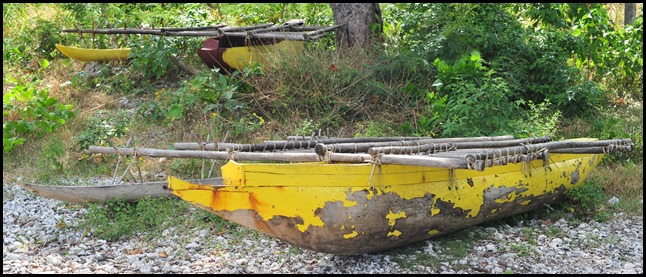 Garanger’s excavations at Magaasi, Fels Cave and Artok revived interest in Roi Mata, locally amongst the communities of Efate and the colonial community, as well as internationally. Garanger’s public presentations of his results in Port Vila drew large crowds. Roi Mata featured in radio shows that told the story of his life and death, and in plays by the national theatre group, Wan Smolbag. Many ni-Vanuatu have since identified the male figure in independent Vanuatu’s coat of arms as Roi Mata, in his new role as a national culture hero. In fact, the coat of arms is reworked from a sketch made in 1849 of a Havannah Harbour chief, together with his wife and child.
The beach now known as Survivor Beach
Roi Mata has also emerged as an international figure through recent reality television shows, starting with the US “Survivor Vanuatu” series, shot on location in 2004, which featured tales of Roi Mata’s exploits and a visit to his grave on Artok Island. The French reality television show “Koh-lanta” followed in 2006, basing itself at Roi Mata’s residence of Magaasi, and in the same year Australia’s “Celebrity Survivor” show was also set on location in Chief Roi Mata’s Domain.
All the ‘stories’ of Roi Mata have been handed verbally through the generations and subject to a bit of ‘Chinese whispers’ so the ‘baptising’ with lake water of the new chiefs by Roi Mata and the chief’s thousand gathered mourners were unsure how to transport his body to Artok Island and the number of canoes needed to get everyone over the sea – it suddenly parted and they all walked across – both seemed a bit too Biblical............
Whatever we heard today, read, or researched, we had a marvellous day. From the Cultural Centre to the village of Topei, to Artok Island to see Roi Mata’s grave, to the cave where he drew his last breath, to Roi Mata’s deserted village and on to our snorkel – what a full and fascinating tour.
ALL IN ALL A WONDERFUL DAY A FANTASTICALLY INTERESTING DAY |

